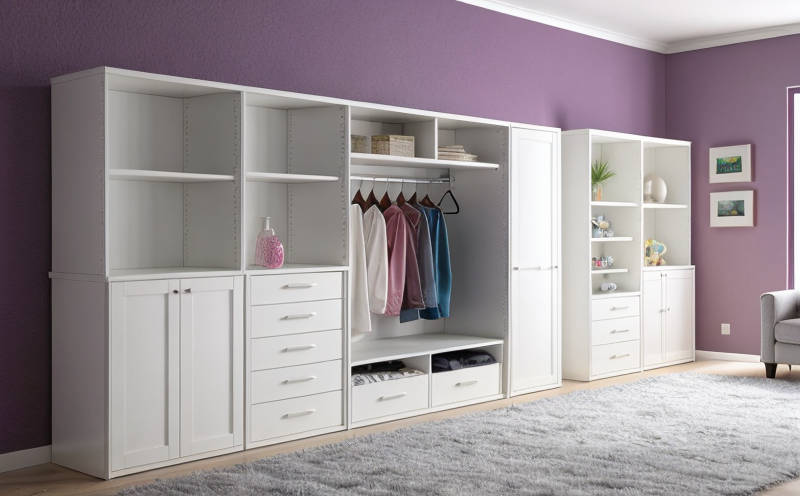ISO 10993 Biocompatibility Testing of Coated Storage Furniture Surfaces
The ISO 10993 series of standards provides a framework for the biocompatibility testing of medical devices. However, its principles and protocols can also be applied to certain non-medical products that come into contact with human skin or mucous membranes, such as storage furniture surfaces that are coated with materials like polyurethane, varnish, or other protective coatings. This service involves a comprehensive suite of tests designed to ensure the safety and biocompatibility of these coated surfaces.
Coated storage furniture can include items such as office chairs, filing cabinets, and shelving units. The coating serves multiple purposes, including aesthetic enhancement, protection against wear and tear, and chemical resistance. Nevertheless, any material that comes into direct contact with the human body must be thoroughly evaluated for its potential to cause adverse reactions. This is where ISO 10993 biocompatibility testing becomes crucial.
The tests under this standard are aimed at identifying substances in the coating that might leach or degrade over time, potentially leading to skin irritation, allergic reactions, or other health issues. The process typically involves several stages:
- Extractables and Leachables Analysis
- In Vitro Testing for Irritation Potential
- Skin Sensitization Testing (if applicable)
- Systemic Toxicity Evaluation
- Genotoxicity Testing
- Bioaccumulation Studies (if necessary)
The first step, Extractables and Leachables Analysis, involves the extraction of chemicals from the coating using solvents. This is followed by a series of in vitro tests to assess the potential for irritation or sensitization. For instance, the Guinea Pig Maximization Test (PGMT) evaluates whether the substance can cause local skin reactions that increase over time. The Skin Sensitization Testing, if required, helps identify allergens that could lead to adverse immune responses.
The next stages involve more systemic evaluations like the in vitro Mammalian Cell Gene Expression Assay (Cytokine Release Assay) and the Ames Test for mutagenic potential. If there is a risk of systemic toxicity or bioaccumulation, further tests are conducted to assess long-term effects on the body.
The results from these rigorous analyses provide critical data that ensures the safety of coated storage furniture surfaces in both commercial and home environments. Compliance with ISO 10993 not only protects end-users but also enhances a company's reputation for quality and reliability.
Benefits
Implementing ISO 10993 biocompatibility testing of coated storage furniture surfaces offers numerous benefits to manufacturers, retailers, and consumers. For manufacturers:
- Enhanced Product Safety: Ensures that the products are free from harmful substances that could cause skin irritation or allergic reactions.
- Regulatory Compliance: Helps in meeting international standards, thereby reducing the risk of product recalls and legal issues.
- Improved Reputation: Establishes a strong brand image as a leader in safety and quality.
- Increased Consumer Trust: Builds confidence among consumers who are concerned about their health and well-being.
For retailers, the benefits include:
- Sustainable Sales: Increased sales due to higher consumer trust in the products sold.
- Competitive Advantage: Differentiation from competitors by offering safer and more reliable products.
Consumers benefit from:
- Health Protection: Reduced risk of adverse health effects from using coated storage furniture.
- Peace of Mind: Knowing that the products they purchase and use are safe and compliant with international standards.
Customer Impact and Satisfaction
The implementation of ISO 10993 biocompatibility testing significantly enhances customer satisfaction by addressing their primary concerns about product safety. By ensuring that coated storage furniture surfaces are free from harmful chemicals, customers can feel confident in their purchases. This confidence translates into higher levels of trust and loyalty towards the brand.
Moreover, meeting international standards such as ISO 10993 not only satisfies regulatory requirements but also demonstrates a commitment to quality and safety. This approach helps build stronger relationships with customers, leading to increased satisfaction and repeat business.
In today's competitive market, where consumer awareness about product safety is growing, implementing this testing process can provide a significant edge in the marketplace. It allows companies to differentiate themselves by offering products that are not only safe but also compliant with stringent international standards.
Competitive Advantage and Market Impact
The adoption of ISO 10993 biocompatibility testing in the production of coated storage furniture surfaces provides a competitive advantage by setting a new benchmark for safety and quality. This approach helps companies stand out from their competitors, who may not have implemented such rigorous testing processes.
By ensuring that all products meet or exceed international standards, companies can:
- Gain Market Share: Attract customers seeking safer and more reliable products, thereby increasing market share.
- Increase Brand Loyalty: Build a strong brand reputation that is associated with safety and quality, fostering long-term customer loyalty.
- Expand Global Reach: Gain access to international markets where stringent regulatory requirements are in place. Compliance with ISO 10993 can facilitate smoother market entry and expansion.
Moreover, the testing process not only meets current regulations but also anticipates future changes in legislation. By staying ahead of the curve, companies can avoid costly compliance issues and maintain their competitive edge.
In conclusion, ISO 10993 biocompatibility testing is a strategic investment that yields long-term benefits for manufacturers, retailers, and consumers alike. It not only enhances product safety but also provides a significant competitive advantage in an increasingly demanding market environment.





